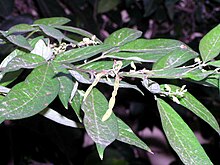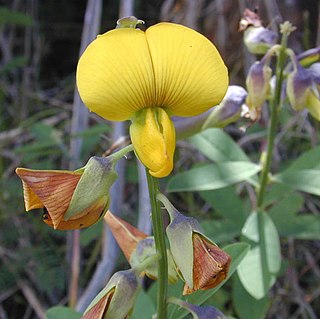
The Faboideae are a subfamily of the flowering plant family Fabaceae or Leguminosae. An acceptable alternative name for the subfamily is Papilionoideae, or Papilionaceae when this group of plants is treated as a family.
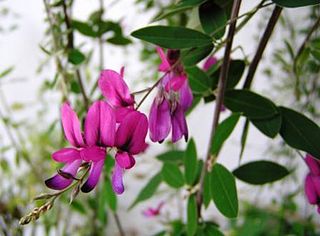
Lespedeza is a genus of some 45 species of flowering plants in the pea family (Fabaceae), commonly known as bush clovers or Japanese clovers (hagi). The genus is native to warm temperate to subtropical regions of eastern North America, eastern and southern Asia and Australasia.

Dipteryx is a genus containing a number of species of large trees and possibly shrubs. It belongs to the "papilionoid" subfamily – Faboideae – of the family Fabaceae. This genus is native to South and Central America and the Caribbean. Formerly, the related genus Taralea was included in Dipteryx.
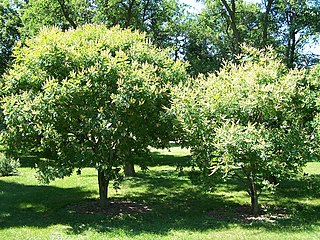
Maackia is a genus of flowering plants in the legume family, Fabaceae. There are 9 species, all native to eastern Asia, from China and Taiwan through Korea, Japan, and the Russian Far East. Six species are endemic to China. The generic name honors the botanist Richard Maack.

Desmodium incanum, also known as creeping beggarweed, Spanish clover, Spanish tick-trefoil or hitchhikers is a perennial plant native to Central and South America. In Hawaiʻi it is known as kaʻimi or kaimi clover from the Hawaiian for "seeker". Initially introduced as forage crop around the world, it has spread to many places although it is no longer an important fodder crop. It is considered a weed both within and outside its native range. It has spread through Florida and across the southern USA into southern Texas and across many Pacific islands, including Hawaii.
Orphanodendron is a genus of legume in the legume family, Fabaceae. It includes two species of trees native to Colombia, which grow in tropical lowland forest. The genus is in subfamily Faboideae.

Isotropis is a genus of flowering plants in the family Fabaceae. The genus is endemic to Australia.

Desmodium paniculatum, the panicled-leaf ticktrefoil, narrow-leaf tick-trefoil or panicled tickclover, is a perennial herb in the pea family, Fabaceae. Belonging to a nearly cosmopolitan genus, the panicled-leaf ticktrefoil is a common native to Eastern North America, ranging from Quebec to Florida and as far West as Texas, Nebraska, and Ontario. The sticky loment can be found in disturbed areas that receive plenty of light, such as roadsides, parks, and abandoned fields.
Baudouinia is a genus of flowering plants in the legume family, Fabaceae. It includes six species which are all endemic to Madagascar. It belongs to the subfamily Dialioideae.
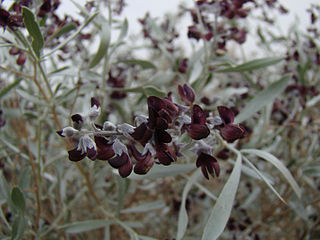
Ammodendron is a genus of flowering plants, called the sand acacias, in the family Fabaceae. It contains five species, which range from Iran through Central Asia to Xinjiang. It belongs to the subfamily Faboideae. Its name is derived from the Greek άμμοςammos ("sand") and δένδρονdendron ("tree").

Amphimas is a small genus of flowering plants in the family Fabaceae. It belongs to the subfamily Faboideae. It is a west African tree used for medicine and for wood. Amphimas was traditionally assigned to the tribe Sophoreae; however, recent molecular phylogenetic analyses reassigned Amphimas into an unspecified position in the Meso-Papilionoideae.
Baphiopsis parviflora is an African species of flowering plants in the legume family, Fabaceae. It is the sole species in genus Baphiopsis. It is a shrub or tree which ranges from Cameroon to Tanzania and Angola.
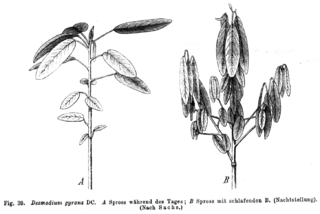
Codariocalyx is a genus of flowering plants in the legume family, Fabaceae. It belongs to subfamily Faboideae. The genus contains two species which range from the Indian Subcontinent, Tibet, Indochina, southern China, Malesia, and New Guinea.

Hylodesmum is a genus of flowering plants in the family Fabaceae, sometimes called ticktrefoils or tick-trefoils. It is sometimes treated as part of Desmodium. It includes 16 species native to eastern North America, sub-Saharan Africa, Yemen, south, southeast, and eastern Asia, Malesia, and New Guinea.

Hypocalyptus is a genus of flowering plants in the family Fabaceae. It includes three species of shrubs, subshrubs or small trees native to the Cape region of South Africa. Typical habitats include Mediterranean-climate shrubland (fynbos) at forest margins, in rocky and sandy areas, and along streams, often at high elevations.
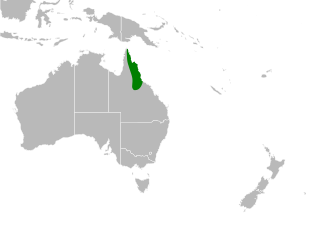
Lamprolobium is a genus of flowering plants in the legume family, Fabaceae. It includes two species endemic to Queensland. It belongs to the subfamily Faboideae.
Mildbraediodendron excelsum is a species of flowering plant in the family Fabaceae, and the only species in the genus Mildbraediodendron. It is a tree native to sub-Saharan Africa, ranging from Ghana to South Sudan, Uganda, and Democratic Republic of the Congo. It grows in Guineo-Congolian forest and Victoria Basin forest–savanna mosaic. It belongs to the subfamily Faboideae.

The tribe Desmodieae is one of the subdivisions of the plant family Fabaceae. It is composed of two subtribes, Desmodiinae and Lespedezinae. Recent phylogenetics has this tribe nested within tribe Phaseoleae.
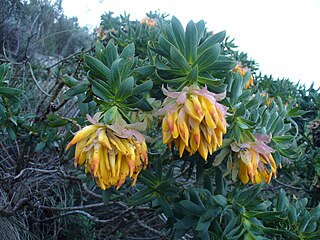
Liparia is a genus of flowering plants in the legume family, Fabaceae. It includes 20 species native to the Cape Provinces of South Africa. It belongs to the subfamily Faboideae.

Ototropis is a genus of flowering plants in the family Fabaceae, found from Afghanistan, the Indian Subcontinent through to southern China including Taiwan, Southeast Asia, Indonesia and on to New Guinea, and introduced to Japan. There has been some nomenclatural confusion regarding this taxon over the centuries.
